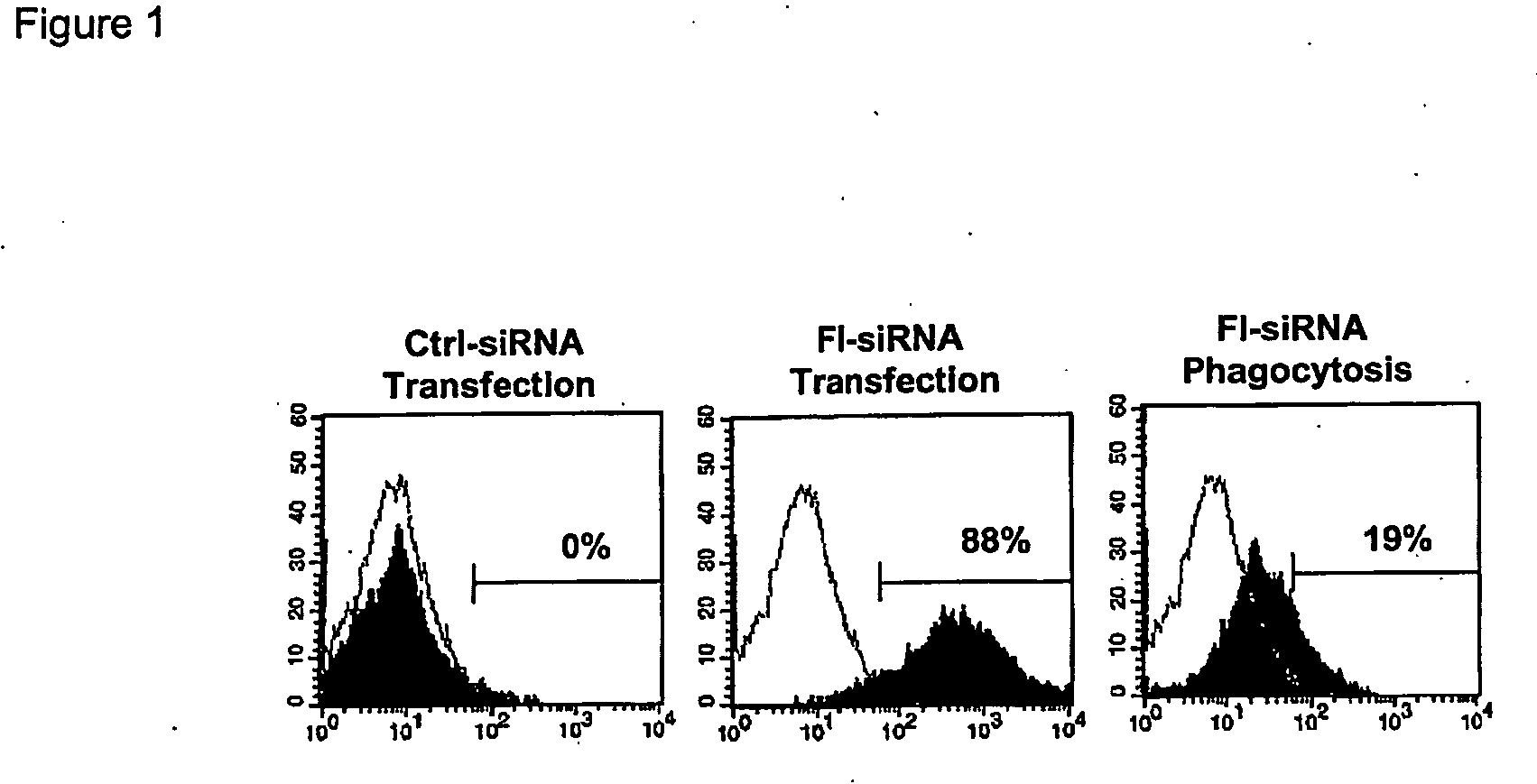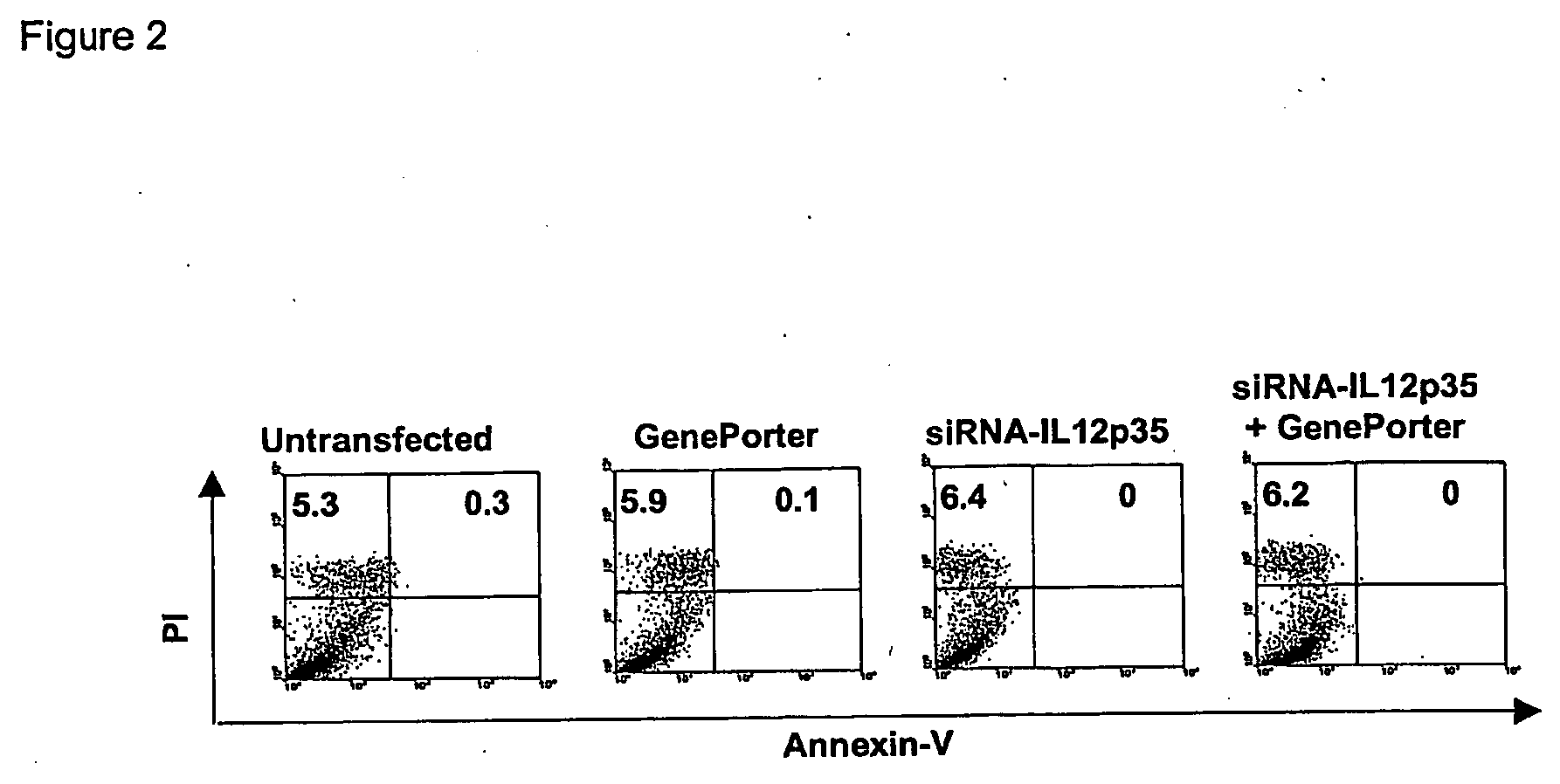Immunomodulation using altered dendritic cells
a technology of dendritic cells and immune cells, applied in the field of immune cells, can solve the problems of low efficiency of rna interference, no direct control of the resulting dc phenotype, and inability to express plasticity in vivo environment, and achieve the effect of suppressing or stimulating immune system functioning, modulating immune responses in a mammal
- Summary
- Abstract
- Description
- Claims
- Application Information
AI Technical Summary
Benefits of technology
Problems solved by technology
Method used
Image
Examples
example 1
Generation of Bone Marrow-Derived DC
[0092] DC were generated from bone marrow progenitor cells as previously described (22). Briefly, bone marrow cells were flushed from the femurs and tibias of C57BL / 6 mice (Jackson Labs, Bar Harbor Me.), washed and cultured in 24-well plates (2×106 cells / ml) in 2 ml of complete medium (RPMI-1640 supplemented with 2 mM L-glutamine, 100 U / ml of penicillin, 100 μg of streptomycin, 50 μM 2-mercaptoethanol, and 10% fetal calf serum (all from Life Technologies, Ontario, Canada) supplemented with recombinant GM-CSF (10 ng / ml; Peprotech, Rocky Hill, N.J.) and recombinant mouse IL-4 (10 ng / ml; Peprotech). All cultures were incubated at 37° C. in 5% humidified CO2. Non-adherent granulocytes were removed after 48 hrs of culture and fresh medium was added. After 7 days of culture >90% of the cells expressed characteristic DC specific markers as determined by FACS. DC were washed and plated in 24-well plates at a concentration of 2×105 cells per well in 400 μ...
example 2
siRNA Synthesis and Transfection
[0093] The siRNA sequences were selected according to the method of Elbashir et al (23). The siRNA sequences specific for IL-12p35 (AACCUGCUGMGGAUGGUGAC), IL-12p40 (MGAUG ACAUCACCUGGACCU), and IFN-γ (MCTGGCAAAAGGATGGTGAC) were synthesized and annealed by the manufacturer (Dharmacon Inc. Lafayette, Co.). siRNA for IFN-γ was used as a control since bone marrow derived DC generated by the conditions described above did not produce IFN-γ after stimulation. Transfection efficiencies were determined using unlabeled and fluorescein labeled siRNA Luciferase GL2 Duplex (Dharmacon Inc). Transfection was carried out as described previously (Elbashir, S. M., 2002. Methods 26:199). Briefly, 3 μl of 20 μM annealed siRNA was incubated with 3 μl of GenePorter (Gene Therapy Systems, San Diego, Calif.) in a volume of 100 μl RPMI-1640 (serum free) at room temperature for 30 min. This was then added to 400 μl of DC cell culture as described above. Mock controls were tra...
example 3
DC Activation and MLR
[0095] Transfected DC (1×106 cells) were plated in 24 well plates and stimulated with LPS (10 ng / ml, Sigma Aldrich, St Louis, Mo.)+TNFα (10 ng / ml, Peprotech) for 48 hrs, at which point supematants were used for ELISA and RNA was extracted from the cells for RT-PCR. For mixed leukocyte reaction (MLR), T cells were purified from BALB / c splenocytes using nylon wool columns and were used as responders (1×106 / well). siRNA-treated DC (5-40×103, from C57 / BL6 mice) were used as stimulators. 72 hour MLR was performed and the cells were pulsed with 1 μCi [3H]-thymidine for the last 18 hrs. The cultures were harvested on to glass fiber filters (Wallac, Turku, Finland). Radioactivity was counted using a Wallac 1450 Microbeta liquid scintillation counter and the data were analyzed with UltraTerm 3 software.
PUM
| Property | Measurement | Unit |
|---|---|---|
| volume | aaaaa | aaaaa |
| volume | aaaaa | aaaaa |
| volume | aaaaa | aaaaa |
Abstract
Description
Claims
Application Information
 Login to View More
Login to View More - R&D
- Intellectual Property
- Life Sciences
- Materials
- Tech Scout
- Unparalleled Data Quality
- Higher Quality Content
- 60% Fewer Hallucinations
Browse by: Latest US Patents, China's latest patents, Technical Efficacy Thesaurus, Application Domain, Technology Topic, Popular Technical Reports.
© 2025 PatSnap. All rights reserved.Legal|Privacy policy|Modern Slavery Act Transparency Statement|Sitemap|About US| Contact US: help@patsnap.com



